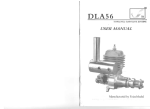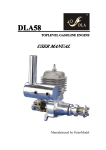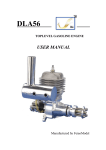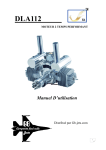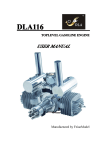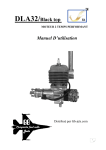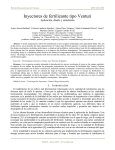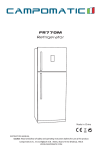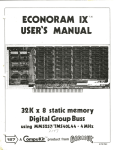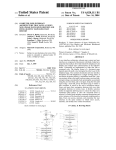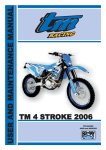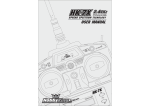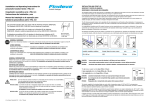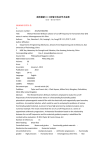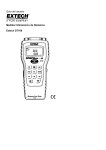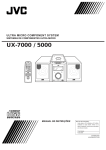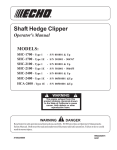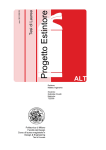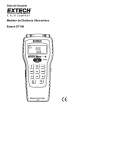Download Manual
Transcript
N ,...-I ,...-I -( ~ 0 ~ Z I-oi (,!) ~ Z ~ ~ z 0 r/} < \!I ~ ~ ~ ~ 0 ~ ~ ~ ~ s ... 0 ~ :::E 0 Q.) CI'j .> ~ Q.) .D "'0 E u <S ::s § :::E J User M anual Thanks for purchasing OLA series engines,please read all of the instructions below before starting your engine, especially the Safety Instructions. About DLA engine Your OLA engine has been specifically design ed, dev el oped and manufactured from proprieta ry co mpone nts for giant scale modeling,it is very powerful, extremely lightweight, easy to adjust and operate, and should provide years of outstanding performance. The main compone nts of the eng ine, such us the s park plug, ign itio n system, be aring and carb are all imported from world famous brands.The crankcases which are machined from aluminum alloy make the eng ines wear and damage res istant. Besides excellent fit and fi nish, precise beari ng align ment is insured, which is critical to engine performance. The reliable auto advancing, our ignition system insures easy starting and exc ellent performan ce . This ignition provi des a powerful spark, yet is full y shielded to insure protection from R/F noise . TE CH NI CAL DATA Perfo rmance: 11.5HP/7500rpm Idle speed:1400rpm/min. 24. 5Kg Pulling Force/1OOmeters Altitude 21Kg Pulling Force/1 800meters Altitude Propeller: 26cm*1 2cm, 27cm*10cm, 28cm*10cm Spark Plug:Special type Parameter: Ehaust Amount: 112cm3 Diameter stroke: 45 .1 mm*35mm Ratio of compression: 7.8:1 Lubrication Ratio: 30:1 (Trial Run) ,40:1-50:140:1 (Normal Flyi ng ) Weight: Main engine -251 Og, muffler-117g, Ignition-120g Safety Instructions before starting engin es WARNING _! This engine is not a toy! Serious injury and lor death can occur from its misuse! READ and becom e familiar with this entire instruction manual. LEARN the engine's applications, lim itations, and possible hazards. DLA is not responsible for any loss, injury or damage resulting from th e miss-use of its products. 1. Keep all spectators at least 30 feet away from the engine while operating the engine . 2. Do not put anything (i .e., fingers, body parts , objects, et al) into the rotating propeller. 3. We ar proper apparel. Do not wear loose clothing, gloves, neckties, jewelry, or neck straps, which may get caught in the moving propeller. 4. Always wear eye protection when starting the engine . 5. Inspect motor mount bolts and firewall integrity before operating the motor. 6. Tu rn off the motor before making any adjustments. 7. Always use the proper size and well-conditioned propeller. 8. Always use the correct length propeller bolts and make sure they are ti ght befo re every flight(sc rew thread - locking glue is recommended). 9. Remember to keep engine fuel in a safe place , awa y from any sparks, excessive heat, or anything which cou ld ignite the fuel. Remember that gasoli ne/mixture is highly flam mable and must be handled with extre me caution . Do not smoke while running or operating the engine. 10.0 0 not run the motor near loose material such as dirt, gravel, power cords, ropes, sand, etc. Loose material can be drawn into the turn ing prop causing injury or damage. En gi ne installation 1. Make sure each engine comes with a firewall mou nting plate drilled with four holes for #10 size screws. 2. A spacer is needed to keep the cool ing fins away from the firewall where the firewall is larger than the engine plate . 3. In order to make sure the engine does not speed excessively without a positive control installed,throttle return springs must be left in place. 4. After you have connected the return spring to the throttle servo you may unhook it ( do not remove it ) ,since it acts as a spacer for the butterfly. The butterfly wi ll work loose by removing the return spring. 5. Th e ignition battery should be mounted externally, near the cowl, at least twelve inches from the receiver or th rottle servo that connects to the receiver. 6. The carburetor need s at least 1 1/2" (38mm) of clearance between the intake and th e bottom of the cowl. If there is less than 1 1/2", make an opening in the cowl below the carb at least as large as the carb intake diameter. 7. A long, narrow, screw driver is recommend to drill small holes in the cowl for adjusting the needle valves, since the carburetor must often be adjusted differently with the cowl on as compared to off. 8.These engines burn between one and two ounces of fuel per minute. Therefore, a 32 ounce or larger tank is recommended . The engines are equipped with a diaphragm pump carburetor making tank location not critical relative to the carburetors fuel entry position. Place the tank on the aircraft's cen ter of gravity (CG). Then aircraft trim changes during flight w ill not be necessary from a full to an empty tank. Fuel : Clean petrol 93# is strongly recommend for your DLA engines. Lubrication Ratio of trial Run is 30: 1 while normal flying is 40: 1, Higher-octane fuel will not generate more power and may cause the engine to run slower and overheat. Note: Damage caused by fuel additives , such as nitro, over-lean carb settings, over-advanced timing, and over-heating are not covered under warranty. Ig n ition system It is important to understand how the ignition system is to be wired. Mount the ignition module using the four supplied rubber grommets so as to create a 1/16" gap between the ignition module and the mounting surface . Without this 1/16" gap the ignition module can overheat. Important: If the electronic ignition overheats it will malfunction (e .g., backfiring or shuttirg down). 7 Ignition details: • The red cable is positive (+) ,while the black is negative(-). • Working voltage : 4.8v-6v. • It is important to achieve the correct coordination of the sensor(s) to the magnets for fitting a new ignition. The propeller selection and installation Make sure the prop, spinner and prop bolts before each flight! Loose prop bolts allow prop movement which will shear the bolts. Selection: • The following props are recommended: 22cm*8cm, 22cm*10cm • Only use propeller sizes that are recommed above for your engine. • The propeller blades must be of the same length. Installation: • You must use a drill press to drill your propeller from the rear. • A drill guide is recommended, but the propeller washer can be used as a drill template. (Fix the propeller washer onto the propeller in the center-bore using a bolt and nut.) • keep your propeller balanced. Engine starting procedure 1. Fill the tank with fresh filtered fuel. 2. Insure that your receiver and ignition batteries are charged, your receiver and transmitter are on. and that your throttle is set to low. 3. Close the choke and turn on the ignition switch. 4. Rubber stick is recommend to start the engine. 5. Begin flipping the prop through its compression stroke until the engine fires . 6. Wait for the propeller to stop spinning, turn off the ignition , and open the choke(s). 7. Switch the ign ition back on and flip the propeller again until the engi ne starts. 8. warm up the engine for 15 or 20 seconds before advancing the throttle. Carburetor Tuning and Care The use of a tachometer is highly recommended. And, again, never adjust the needles while the engine is runningl Tuning 1. Using the tachometer tune the engine for maximum power with the high needle (H). 2. Using the tachometer again: richen the high needle (H) until the motor runs 100-200 RPM less th an the maximu m RP M. Now you should ric he n slig htl y on the high needle (H). Keep the engine run at idle for 60 seconds. Insure that the idle RPM to be constant. If the low needle (L) is too rich,it may happen that idle RPM drops until the engine stops ; Lean the low needle (L) until a constant id le RPM is achi eve d. Check th e transition with a quick throttle ad vance. It should sound like it is making quick steady power. Care: Your carbureto r scre en will need to be cl ea ned with clea n gasoline and blow off with compressed air after every flight. Check the choke and throttle plates for tightness, Trouble Shooting Problem1. The engine is flooded. Solution: Remove the spark plug ; turn the engine to a position where the fuel runs out and clean it. Check the connections of spark plug, screws, restart the engine. If it fail ed to start again, please send it back to After-sale servi ce center for repair. Problem 2. The engine starts after being choked but then stops soon after. Solution : The low needle on the carburetor is probably too lean . Adj ust the Low End needle until you achieve a smooth idle and a reliable transition to high throttle. Generally if the motor stutters or coughs in the mid range or when the throttle is advanced, the low end needle is too rich and possibly even the hig h end needle. Problem3. The engine runs rou gh and is vibrating strongly. Solution: Balance the propeller. Ch eck the ignition timi ng. Check your plumbing for air/fu el leaks. Check you r spark plug for carbon and check the spark plug gap. Check the motor mount to be sure it is rigid. Check to make sure the engine is mounted on a level surface so that cra nkcase is free of tension. Check the engine and propeller bolts. Problem4. The engine doesn't reach a normal RPM at full throttle . Solution: Check: A. The carb uretor settings. B. See if the propeller is too large. C. See if the engine is overheating. D. The ignitiontiming. E. The spark plug for defect. Verify: A. You have the correct muffler system . B. You have the correct gasoline, oil, and havemixed them with the correct ratio. DLA WARRANTY POLICY DLA e'n gines include a limited TWO YEAR WARRANTY ON MATERIALS AND WORKMANSHIP to the original purchaser. This warranty does not cover the following: • Damage caused by improper handling , operation, modifications, or maintenance. • Damage caused by a crash. • Damage caused by using improper fuel or additives. • Damage incurred during transit to after service center. Company: Xi'an FeiaoModel CO. ,Ud. Address : Tel: Fax: Email: 506, Xitie Gongcheng Building, NO.205 Jinhuabei Road, Xi'an, 710032, Shaanxi, China 0086·29· 68965278 0086·29· 82197815 Jessica: [email protected] Vera:[email protected] Emily:[email protected]





